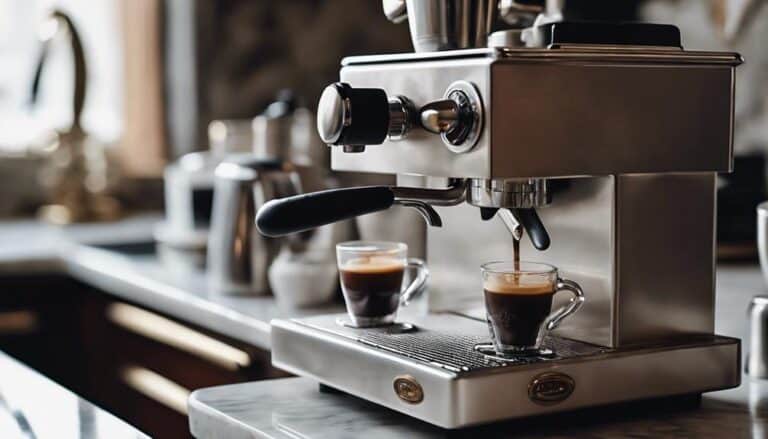How to Brew Tea With Your Coffee Maker
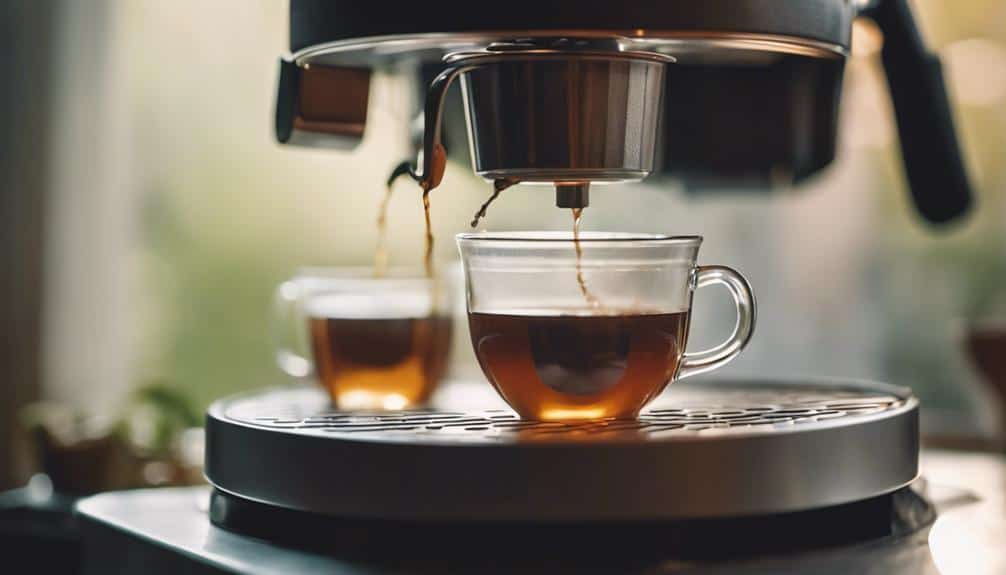
When it comes to brewing tea with your coffee maker, there's a surprising versatility that often goes unnoticed. The importance of this method can elevate your tea-drinking experience, but it's essential to understand a few key steps to guarantee a perfect brew every time. From water temperature to steeping time, mastering this technique can open a world of possibilities for tea enthusiasts. So, let's explore how a simple switch in your routine can lead to a rich, aromatic cup of tea that might just surprise you.
Water Reservoir Preparation
To guarantee the quality of your brewed tea, it's vital to carefully select and use fresh, clean water in the coffee maker's reservoir. When preparing the water reservoir for brewing tea, it's important to avoid using tap water or distilled water as they can impact the flavor of the tea. Make sure the reservoir is clean and free of any coffee residues before filling it with water. Adjust the water level in the reservoir according to the amount of tea you plan to brew to achieve the desired strength and flavor.
Proper preparation of the water reservoir is essential for achieving excellent tea extraction and flavor. By starting with fresh, clean water and maintaining the cleanliness of the reservoir, you set the foundation for a delicious cup of tea. The quality of the water used directly influences the quality of the brewed tea, making this step a critical aspect of the brewing process. Paying attention to these details will enhance your tea brewing experience and ensure a delightful cup every time.
Tea Selection and Quantity
When brewing tea in a coffee maker, it's essential to take into account the type of tea and the amount needed. For a standard strength, one tea bag per cup of water is usually sufficient, but doubling the amount can enhance the flavor.
Personal taste preferences play a significant role in determining the ideal tea quantity, so don't hesitate to adjust and experiment to find the perfect balance.
Tea Types and Amounts
In the art of brewing tea with a coffee maker, the type of tea chosen greatly influences the amount of leaves required for a perfect infusion. Green tea generally needs fewer leaves compared to black tea for a balanced flavor. However, Herbal teas might demand a higher quantity of leaves to achieve a robust brew.
It's crucial to refer to the tea package for the recommended amount to guarantee proper brewing. The loose tea leaves should be measured with care to avoid an overpowering taste or a weak infusion. Depending on personal preference, one can adjust the tea quantity to tailor the strength of the brew.
Understanding the specific requirements of different tea types is key to achieving a delightful cup every time.
Brewing Tea Ratios
For achieving the ideal tea strength in your coffee maker, the key lies in selecting the appropriate type of tea and carefully measuring the quantity of leaves based on the recommended ratios. Different teas require varying amounts for the best brewing, typically one tea bag per 6 or 8 ounces of water.
It's important to think about doubling the tea amount for a stronger flavor, especially when water passes quickly through the tea leaves. Checking the tea package for recommended water quantities guarantees the perfect cup of tea.
Proper measurement of tea and water ratios is vital for a well-balanced and flavorful brew. Adjust the tea quantities based on personal preferences and desired tea intensity when using a coffee maker to make the perfect cup of tea.
Selecting Tea Varieties
Selecting the ideal tea variety for your brewing needs involves considering the unique flavor profiles and steeping requirements of green tea, black tea, herbal tea, and white tea. Each type of tea brings distinct characteristics to the brewing process.
Green tea offers a delicate flavor with lower caffeine content, requiring cooler water and shorter steeping times. Black tea, on the other hand, boasts bold flavors and higher caffeine levels, necessitating hotter water and longer steeping durations.
Herbal teas, known for their diverse infusions, often require boiling water and varying steeping times based on the ingredients. White tea, with its subtle and nuanced taste, benefits from lower water temperatures and gentle steeping.
Understanding these nuances and experimenting with different tea varieties will enhance your brewing skills and expand your palate. Remember, the quantity of tea used per cup also plays an essential role in achieving a well-balanced and flavorful brew.
Brewing Cycle Initiation
Before brewing tea in your coffee maker, it's essential to start the brewing process by adding the tea leaves or bags.
Setting the brewing time according to your tea type and desired strength guarantees a perfect cup.
Throughout the brewing cycle, monitor the progress to achieve the ideal flavor and aroma in your tea.
Start Brewing Process
Upon powering on the coffee maker, the brewing cycle for the tea is initiated by ensuring the water reservoir is filled with the desired amount of water and the filter basket is in place with the tea bags.
The coffee maker will then start heating the water to the appropriate temperature required for steeping the tea effectively. As the water heats up, the brewing process begins, allowing the tea to infuse its flavors into the water.
The brewing cycle typically takes a few minutes to complete, ensuring that the tea is brewed to perfection. This method provides a convenient and efficient way to make a delicious cup of tea using your coffee maker, giving you the freedom to enjoy a soothing beverage whenever you desire.
Set Brewing Time
To guarantee maximum extraction of flavors, I recommend setting the brewing time for your tea in the coffee maker within the range of 3 to 5 minutes. This timeframe allows the tea flavors to develop fully without becoming too bitter or weak.
Adjusting the brewing time can help tailor the tea strength and flavor intensity to your liking, ensuring a personalized tea experience. By letting the coffee maker complete the brewing cycle uninterrupted, you can effectively extract tea flavors for a well-rounded taste profile.
Consistent brewing times are key to achieving the desired tea taste every time you brew. Experimenting with the brewing time will help you find the perfect balance and elevate your tea brewing skills for a delightful tea-drinking experience.
Monitor Brewing Progress
Monitoring the brewing progress in your coffee maker involves observing the initiation of the brewing cycle to guarantee the best extraction of flavors from the tea. As the hot water flows through the coffee maker and interacts with the tea bags, it initiates the tea brewing process. This vital step sets the stage for excellent flavor development.
Tea Transfer and Enjoyment
When transferring the freshly brewed tea from the coffee maker, it's crucial to handle it carefully to preserve its flavor and heat. As you transfer your tea, here are some tips to enhance your tea-drinking experience:
- Transfer brewed tea from the coffee maker to a teapot or cup for serving.
- Allow the tea to cool slightly before enjoying to avoid burning your tongue.
- Use a strainer to catch any loose tea leaves that may have passed through the filter.
- Add sweeteners or garnishes like honey, lemon, or mint to enhance the tea's flavor.
- Enjoy the freshly brewed tea while it's still hot for the best taste experience.
Taking these steps guarantees that your tea isn't only flavorful but also enjoyable from the moment it's brewed. By paying attention to these details, you can savor each sip of your freshly brewed tea.
Regular Coffee Maker Cleaning
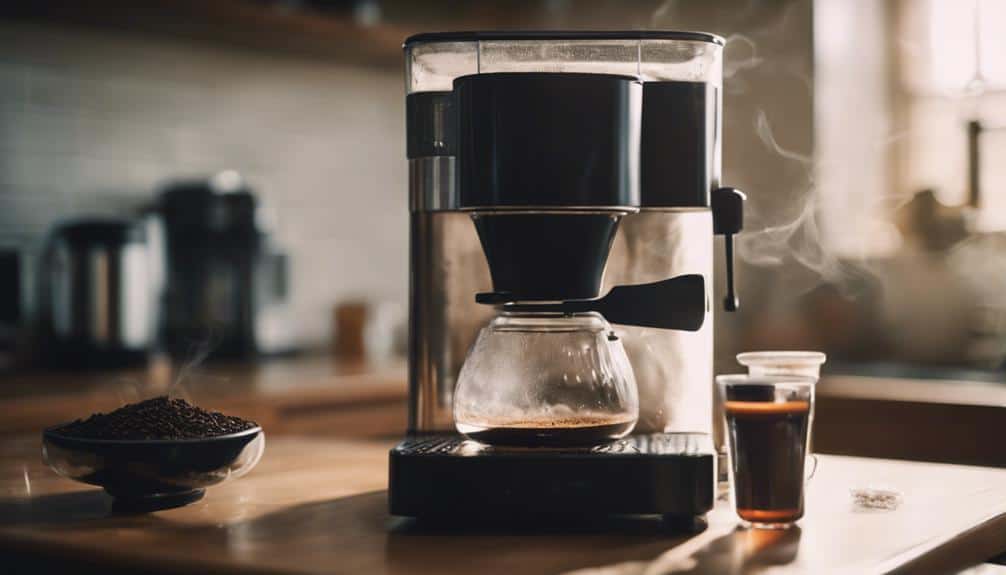
For ideal tea brewing results, maintaining a clean coffee maker is essential. Cleaning the coffee maker with a solution of vinegar and water effectively removes all coffee residue, ensuring a fresh and untainted tea taste. Neglecting to clean the coffee maker may lead to the unwanted transfer of old coffee flavors to your tea, compromising its quality. After cleaning, it's important to run hot water through the coffee maker to eliminate any lingering vinegar or water residue that could affect the tea's flavor.
Regularly cleaning your coffee maker is essential to establishing excellent brewing conditions for tea. Proper cleaning before brewing tea guarantees a pure and fresh flavor, enhancing the overall tea-drinking experience. By adhering to a routine cleaning schedule and using the right cleaning agents, you can maintain the integrity of your coffee maker and consistently enjoy delicious tea with every brew.
Experimenting With Tea Varieties
Exploring a variety of tea options in your coffee maker can lead to delightful discoveries of unique flavors and health benefits inherent in different tea varieties. When using a coffee maker to brew tea, experimenting with various tea types can enhance your tea experience.
Here are some ways to make the most of this adventure:
- Discover New Flavors: Try brewing green tea for a grassy taste, black tea for a robust flavor, oolong tea for a floral aroma, or herbal teas for a caffeine-free infusion.
- Health Benefits: Green tea is rich in antioxidants, black tea offers theaflavins, and herbal teas like chamomile promote relaxation and digestion.
- Water Temperature: Adjust the water temperature to suit the specific tea variety you're brewing for the best taste.
- Number of Cups: Determine how many cups of tea you want to make to ensure the right amount of tea leaves in the filter.
- Brewing Time: Experiment with different brewing times to find the perfect balance between strength and flavor extraction.
Understanding Tea Packaging Types
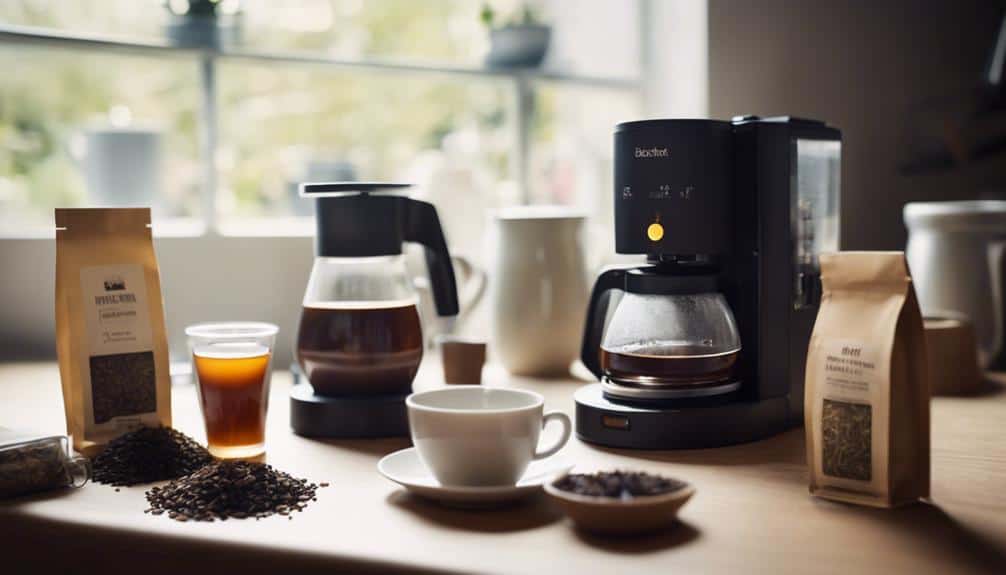
In exploring different tea varieties for brewing in a coffee maker, understanding the various types of tea packaging plays a vital role in enhancing the overall tea brewing and tasting experience. The choice between loose leaf tea, pyramid tea bags, and square paper tea bags has a substantial impact on the flavor extraction and brewing experience.
Loose leaf tea allows for a full-bodied taste, multiple steepings, and a rich aroma, providing a premium tea experience. Pyramid tea bags combine the convenience of traditional teabags with the high-quality flavor of loose leaf tea, offering a balanced and flavorful brew. On the other hand, square paper tea bags deliver a fuller-bodied infusion compared to round tea bags, ensuring a robust and aromatic cup of tea.
Selecting the right packaging type is important as it influences the strength, aroma, and overall quality of the brewed tea. Each tea packaging type contributes uniquely to the brewing process, ultimately shaping the tea-drinking experience.
Selecting a Steeping Vessel
When selecting a vessel for steeping tea, consider the importance of using the right tool to enhance the brewing process and elevate your tea-drinking experience. Here are some key points to keep in mind:
- Teacups: Perfect for individual servings, allowing you to enjoy your tea right from the vessel it was brewed in.
- Teapots with Strainers: Ideal for brewing larger amounts of tea, providing convenience and ease of straining.
- Infusers: Great for brewing loose leaf tea without the need for a separate strainer, keeping your tea experience mess-free.
- French Presses: Surprisingly versatile for steeping tea, offering a different brewing method that can enhance flavors.
- Electric Kettles: With temperature control settings, these kettles make it easy to achieve the perfect water temperature for brewing various types of tea.
Selecting the right vessel tailored to your preferences can have a significant impact on the quality of your tea, ensuring excellent flavor extraction from the tea plant and a delightful tea-drinking experience.
Brewing Tea on Ice
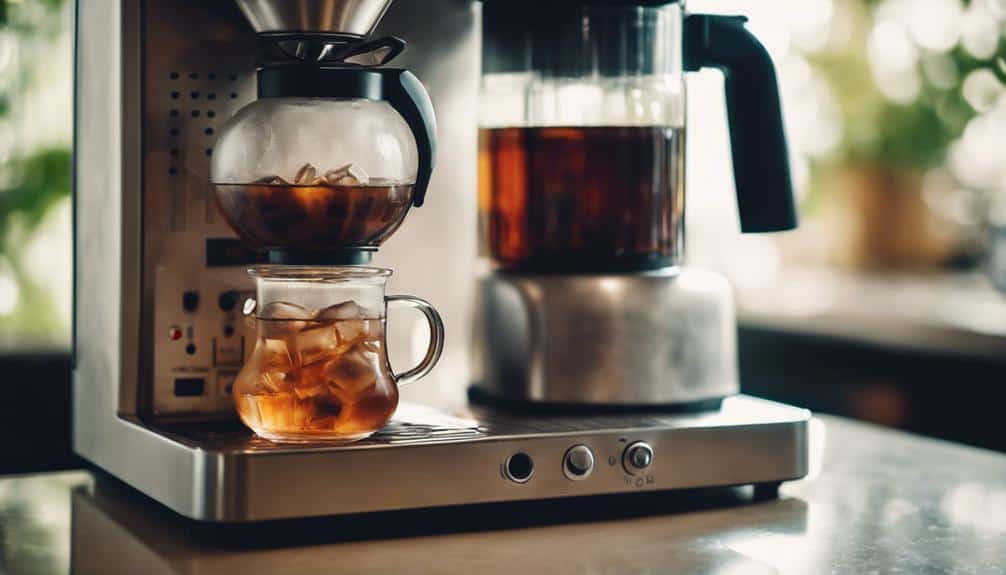
To achieve a perfectly invigorating and flavorful iced tea, one must steep the tea at double strength to accommodate the subsequent dilution with ice. When brewing tea on ice, using half the usual amount of water for steeping is vital. This concentrated brew poured over ice allows for quick cooling without diluting the taste. Cold brewing tea on ice is another method that results in a revitalizing and aromatic iced tea.
When preparing iced tea, it's essential to adjust the strength and sweetness according to personal preference. Experimenting with different tea types and flavors can lead to unique and delightful iced tea variations. Some teas may require longer steeping times or different temperatures to achieve the desired strength when brewing on ice. Additionally, exploring various sweeteners or garnishes like mint or citrus can elevate the flavor profile of your iced tea.
Embrace the freedom to create your perfect cup of iced tea by experimenting with different brewing techniques and flavor combinations.
Conclusion
In conclusion, brewing tea with your coffee maker is a simple and convenient way to enjoy a fresh and flavorful cup of tea. By following the outlined steps and experimenting with different tea varieties, you can tailor your tea-drinking experience to your preferences.
Regular maintenance of your coffee maker will guarantee ideal brewing conditions, allowing you to savor the delicious taste of tea every time.
Cheers to brewing the perfect cup of tea with your coffee maker!



